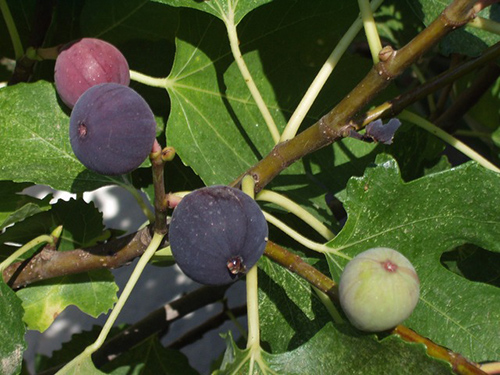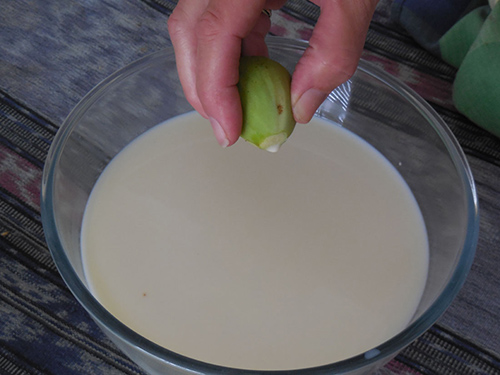Contents

800 years ago, the famous Greek botanist and physician Dioscorides wrote the following words about the fruit of the fig tree:
When cooked, mashed, and applied as a poultice, they break up any skin hardening, make pustules softer, and ripe furuncles and abscesses.
Pedanius Dioscorides
He continued praising figs’ healing virtues on any sores and wounds. After seeing the remedy’s effectiveness in his patients, he wrote those words in his journals. Some 2700 years later, many other therapeutic applications of this ancient tree have been discovered.
Fig Tree Scientific Facts
- Other names: Common fig
- French: Figuier
- Spanish: Higuera
- Environment: Widely spread all over the Mediterranean basin, and at present also in dry, sunny areas of America
- Description: Tree of the Moraceae family, with softwood, milky sap, and large rough leaves. The figs, incorrectly called fruit, are the fleshy flowers of the fig tree.
- Parts of the plant used medicinally: The figs, the leaves, and the latex
Healing Properties and Indications

Figs are especially rich in sugars: sucrose, glucose, and saccharose. They also contain small amounts of proteins, fats, mineral salts, vitamins A, B1, B2, and C, and organic acids. The use of figs is mainly recommended for people suffering from constipation (laxative properties), pregnant women, and people suffering from mental or physical exhaustion.
The liquid obtained from a decoction of dried figs has soothing properties on irritated digestive and respiratory mucosa. It offers good results for pharyngitis, gastritis, bronchitis, irritative cough, and skin rashes.
When externally applied as a poultice, figs have healing and resolvent properties, promoting the ripening of abscesses and inflammation. They are used for infected wounds, furuncles, pimples, and dental gum boils.
Ten Amazing Benefits of The Fig Tree
1. Promotes Digestive Health: Figs are an excellent source of soluble and insoluble fiber, aiding in bowel regularity, preventing constipation, and nourishing beneficial gut bacteria.

2. Supports Heart Health: Figs contain potassium, a mineral necessary for blood pressure regulation. Studies suggest fig extracts may benefit blood lipid profiles, contributing to a lower risk of heart disease.
3. May Aid Blood Sugar Control: Figs have a moderate glycemic index, and their fiber content slows sugar absorption, helping maintain stable blood sugar. Fig leaf extracts show potential for diabetes management.
4. Rich Source of Antioxidants: Figs provide vitamins A, C, and E, plus polyphenols, which combat oxidative stress and reduce inflammation linked to chronic disease.
5. Bone Health Support: The rich calcium content in dried figs makes them a good option for boosting bone mineral density, which is significant for those with lactose concerns.
6. Potential Anticancer Properties: Fig leaves and latex contain compounds that exhibit antitumor activity against various cancer types in test-tube studies. However, human research is required to confirm these benefits.
7. Good Source of Minerals: Figs offer an array of minerals, including iron, magnesium, potassium, and copper, all essential for numerous bodily functions.
8. May Support Menstrual Health: Traditionally used to alleviate some menstrual issues, figs boast natural compounds that could influence hormonal balance. Consult a healthcare professional for tailored advice.
9. Skin Health Potential: The topical application of fig leaf sap is traditionally used for warts and skin conditions. Its antioxidant and anti-inflammatory effects may have broader skin benefits.
10. May Aid Weight Management: Figs are naturally sweet and fiber-rich, providing a filling snack or ingredient to help curb cravings and potentially support weight goals in a balanced diet.
Preparation and Use
- Dry figs: To treat constipation, take on an empty stomach in the morning, around 200g of dried figs, which must have been put to soak the night before.
- Decoction: Prepared with 10 or 12 dry figs per liter of water or milk. Boil until the liquid reduces by half. Drink three or four hot cups daily to combat digestive or respiratory afflictions. Figs can also be eaten when cooked.
- Poultices: Mash a handful of fresh figs or soaked dry figs, and with the resulting paste, prepare a poultice, which is applied once wrapped in a cotton cloth, on the affected area. Leave it there during the daytime and remove it at night, washing the skin. A fig cut in half may also be applied.
- Latex: Apply some drops on warts every day for several weeks.

Fig Tree Milk
The milk or tear of the fig tree, the name Dioscorides gave to the white sap (latex), which flows from the leaves and branches, contains several enzymes that curdle milk and even digest meat. This latex is used to soften calluses and eliminate warts. You must be patient and apply results daily for several weeks to obtain results. You can apply a mashed hot fig tree leaf on warts like a poultice.
DISCLAIMER: All content on this website is presented solely for educational and informational objectives. It would be best to not rely on the information provided as a replacement for advice, diagnosis, or treatment from a qualified medical expert. If you are pregnant, nursing, or have any preexisting medical concerns, you should talk to your doctor before using any herbal or natural medicines.
REFERENCES
- George D. Pamplona-Roger, M.D. “Encyclopedia of Medicinal Plants.” George D. Pamplona-Roger, M.D. Encyclopedia of Medicinal Plants. Ed. Francesc X. Gelabert. vols. 2 San Fernando de Henares: Editorial Safeliz, 2000. 708,709. Print.
- WebMD: https://www.webmd.com/
- Healthline: https://www.healthline.com/
- Mayo Clinic: https://www.mayoclinic.org/
